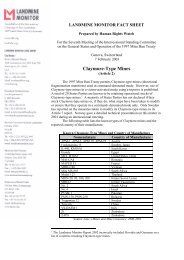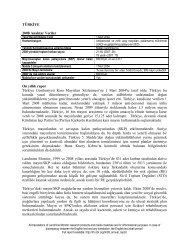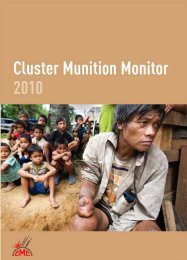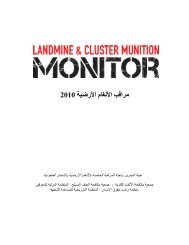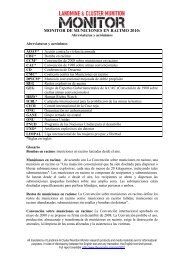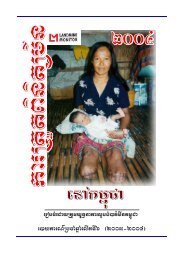Download PDF - Landmine and Cluster Munition Monitor
Download PDF - Landmine and Cluster Munition Monitor
Download PDF - Landmine and Cluster Munition Monitor
You also want an ePaper? Increase the reach of your titles
YUMPU automatically turns print PDFs into web optimized ePapers that Google loves.
<strong>Cluster</strong> <strong>Munition</strong> <strong>Monitor</strong> 2012<br />
Gender status<br />
Where the gender was recorded (8,976 casualties), the majority of civilian casualties were male (83%) <strong>and</strong> significant<br />
proportion were female (17%). For 1,471 civilian casualties, the gender was not recorded. See the following table <strong>and</strong><br />
chart.<br />
Recorded civilian cluster munition<br />
casualties: Gender<br />
Male 7,413 71%<br />
Female 1,563 15%<br />
Unknown 1,471 14%<br />
Total 10,447 100%<br />
Female<br />
17%<br />
Male<br />
83%<br />
Worst-affected states<br />
According to the Beirut Progress Report issued by the Second Meeting of<br />
States Parties in September 2011, States Parties Afghanistan, 10 Lao PDR, <strong>and</strong><br />
Lebanon, signatory Iraq <strong>and</strong> non-signatories Cambodia <strong>and</strong> Vietnam “are<br />
considered to be the worst affected with responsibility for the care of several<br />
thous<strong>and</strong>s of victims.” 11 Three-quarters of all cluster munition casualties have<br />
been recorded in States Parties (Afghanistan, Bosnia <strong>and</strong> Herzegovina (BiH),<br />
Lao PDR, <strong>and</strong> Lebanon) <strong>and</strong> signatories (DRC, <strong>and</strong> Iraq) to the Convention on<br />
<strong>Cluster</strong> <strong>Munition</strong>s, as detailed in the following table.<br />
In 2011, as in past years, information available to the <strong>Monitor</strong> shows that no<br />
state has reported or provided any estimates of the total number of its cluster<br />
munition victims. Similarly, no states have provided information in their<br />
reports about the families <strong>and</strong> other directly-affected members of communities<br />
living in their jurisdiction.<br />
<strong>Cluster</strong> munition casualties in 2011<br />
In 2011, based on incomplete data, at least 55 new cluster munition casualties<br />
were confirmed in five countries <strong>and</strong> one other area: States Parties Lao PDR<br />
(13) <strong>and</strong> Lebanon (3); signatory Iraq (16); non-signatories Cambodia (16) <strong>and</strong><br />
Sudan (6); <strong>and</strong> Western Sahara (1).<br />
However, data remains inadequate <strong>and</strong>/or irregular in most contaminated<br />
countries. Most likely, there were significantly more casualties from cluster<br />
munition remnants among the other hundreds of casualties from explosive<br />
remnants in the countries that did not separate cluster munitions <strong>and</strong>/or<br />
submunitions in their data, or were unable to do so adequately. For example,<br />
States <strong>and</strong> areas with more than<br />
100 recorded cluster munition<br />
casualties<br />
States/areas<br />
Recorded<br />
casualties<br />
Lao PDR 7,592<br />
Iraq 3,011<br />
Vietnam 2,111<br />
Afghanistan 774<br />
Lebanon 707<br />
BiH 231<br />
DRC 207<br />
Kosovo 203<br />
Cambodia 202<br />
Kuwait 198<br />
Note: Convention on <strong>Cluster</strong> <strong>Munition</strong><br />
States Parties <strong>and</strong> signatories are<br />
indicated by bold <strong>and</strong> other areas by<br />
italics<br />
throughout most of Iraq there is still no effective <strong>and</strong> functioning data-collection mechanism <strong>and</strong> the <strong>Monitor</strong> remains<br />
reliant on media reporting that usually fails to distinguish between the various types of explosive devices causing<br />
casualties. Only two of Vietnam’s 58 provinces have some form of data collection on casualties. Data collected in Lao<br />
PDR also continues to lack detailed information.<br />
In Libya, media reports identified four casualties from unexploded submunitions between April <strong>and</strong> June 2011. 12<br />
However, it was not possible to distinguish whether these or other casualties were caused by explosive remnants of war<br />
that were not cluster munition remnants. 13<br />
10<br />
At the time of Beirut Progress Report, Afghanistan was a signatory.<br />
11<br />
“Draft Beirut Progress Report,” CCM/MSP/2011/WP.5, 25 August 2011, pp. 10-11. http://www.clusterconvention.org/files/2011/05/Beirut-<br />
Progress-Report-ODS-upload4.pdf.<br />
12<br />
UNICEF, “Libya: Protecting children from unexploded ordnance,” Misrata, 6 June 2011. http://bit.ly/jyrPzi; Ruth Sherlock, “Unlucky camel<br />
finds Libya’s largest minefield,” Al Jazeera, 28 June 2011. http://aje.me/iWMTQP; email from James Wheeler, Photographer, 10 August<br />
2011; <strong>and</strong> UNICEF, “UNICEF Situation Report # 19 - Sub-regional Libya crisis,” 29 June 2011. http://bit.ly/PfEUVx.<br />
13<br />
Two of the four reported submunition casualties, boys of 15 <strong>and</strong> 10 years old who were injured in Ajdabiya, were also later reported to have<br />
been injured by a h<strong>and</strong> grenade. UNICEF, “Libya: Protecting children from unexploded ordnance,” Misrata, 6 June 2011. http://bit.ly/jyrPzi.<br />
The explosive item type of the remaining two casualties could not be confirmed <strong>and</strong> they were recorded as ERW casualties by the Libyan<br />
Mine Action Center (LMAC). Casualty data provided via emails from Abdulmonem Alaiwan, Director, LMAC, 17 June 2012; <strong>and</strong> Jennifer<br />
Reeves, Weapons Contamination Coordinator, ICRC, 16 July 2012.<br />
54



